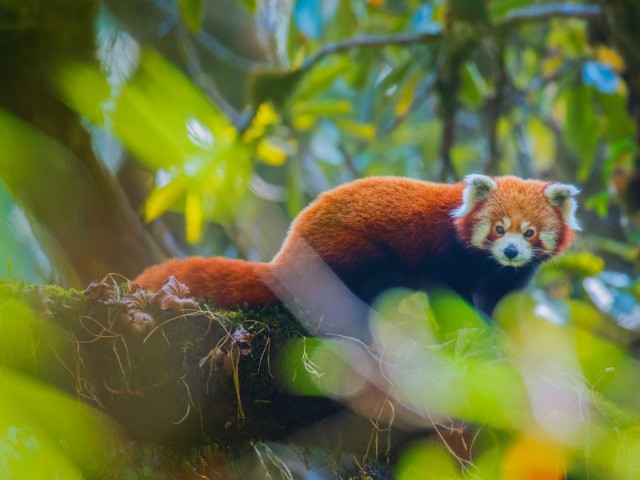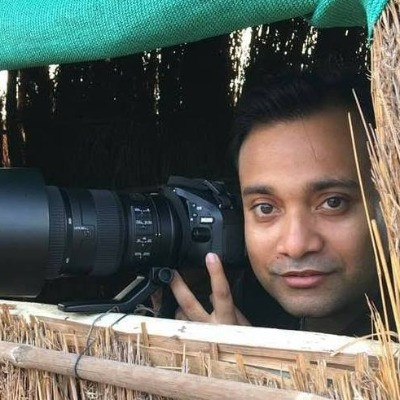
Singalila National Park
Known for its stunning views of the eastern Himalayas and rich biodiversity, it is one of the best places to see the elusive and endangered Red Panda in its natural habitat
Tapash Roy | Moon Jana Roy
Singalila National Park is one of the last remaining natural habitats of the endangered Red Panda. According to a 2014 census, there are 27 individuals within the park. Photograph: Sourav Mondal
Singalila National Park
The high-altitude national park (2500-3650m) is situated on the Singalila Ridge in the Darjeeling district of West Bengal and spans an area of 78.6sq.km. The park shares a natural boundary with Nepal in the west and Sikkim in the north.
The mountain forests of Singalila boast an astounding diversity of flora and fauna. It is one of the last remaining natural habitats of the endangered Red Panda.
The national park offers panoramic views of the eastern Himalayas, including four of the five highest peaks in the world―Mount Everest, Kangchenjunga, Lhotse, and Makalu. The famous trek route to Sandakphu (3636m), the highest peak in West Bengal, runs through the national park, making it a popular destination among adventure seekers and trekkers.
Plan Your Trip
Getting There
Air
Bagdogra Airport (IXB) in Siliguri, West Bengal, is the nearest airport.
Rail
The nearest narrow gauge rail station (toy train) is Ghoom and the closest broad gauge rail station is New Jalpaiguri Junction (NJP).
Road
Manebhanjan (2150m), a small Himalayan hamlet, is the gateway to the national park. From New Jalpaiguri Junction and Bagdogra Airport, the distance to Manebhanjan is about 85km via Mirik. It is also well connected with the nearest town of Darjeeling (25km) via Ghoom. Be sure to reach Manebhanjan early since car entry inside the national park is only allowed between 7 AM to 2 PM.
From Manebhanjan, either you can start trekking the mountain trails or hire a vintage British Land Rover to reach the national park.
It is approx. 13km from Manebhanjan to Tumling. The entrance of the national park is about 1km away from Tumling.
The road gives way to a bumpy, gravel path from Gairibas, a small mountain village 12km away from Sandakphu (3636m) and continues to Phalut (3595m). There is a chance some commuters may suffer from car sickness on this route. Sandakphu is about 32km away from Manebhanjan.
Best Time To Visit
Spring and Summer (March to May):
The park is magical in spring. The forests are a riot of colours, with rhododendrons and orchids in full bloom. Birds come out in the open to harvest nectar from the spring bloom, which makes it the best season for bird watching. It is also the best time to see Red Pandas with cubs. During this period, the minimum temperature stays between 1-10°C.
Monsoon (June to September):
The national park remains closed from June 15 to September 15 because of heavy downpours and frequent landslides.
Autumn (October to November):
Afresh from the monsoon rains, the park opens its door to travellers. The snow-white peaks of the eastern Himalayas adorn the azure autumn sky, and the forest flaunts the colours of fall foliage. Kiwi and Sorbus, the favourite fruits of the Red Panda, ripen during this time, increasing the chances of sightings in the open. During this period, the minimum temperature stays between 10-15°C.
Winter (December to February):
Singalila experiences a harsh winter. With frequent snowfall, the minimum temperature goes below 0°C. This is the mating season for Red Pandas.
History
Singalila in Darjeeling was purchased by the British Government from the Sikkim Darbar in 1882 and was notified as a reserve forest under the Indian Forest Act of 1878. Later, in 1992, the region was notified as a national park and was officially opened up for tourism.
Some of the noteworthy historical visitors to Singalila:
- Sir Joseph Dalton Hooker, the famous British botanist and explorer, visited the Singalila Ridge in the mid-19th century and published the book Himalayan Journals, detailing his travels and discoveries of new plant specimens.
- Heinrich Harrer, the author of Seven Years in Tibet, is believed to have visited Singalila several times.
- The Singalila Ridge used to be a regular route for expeditions to Mt. Khangchendzonga. Sir Tenzing Norgay Sherpa felicitated the first Khangchendzonga summitters on their return from the mountain at Sandakphu in 1955.
Stay
A minimum of five nights and six days is recommended for those who either plan to explore the wildlife of the park or trek to Sandakphu. There are only a handful of stay options available within the national park.
Habre is a Nepali word, it means Red Panda. If you are a wildlife enthusiast and plan to visit Singalila, especially for Red Panda sightings, Habre’s Nest is the place for you. It is situated in Kaiakata Village, Illam, in the Tinchuley Forest, the extension of the national park on the Nepal side of the trek route to Sandakphu.
The homestay has all the modern amenities required for a comfortable stay. There is a team of 15 to 20 villagers who provide excellent hospitality and dedicatedly work for the protection of the surrounding Red Panda habitat. They are also the best trackers of Red Pandas in the park. Habre's Nest contributes 20 per cent of its profits to the conservation of the Red Panda and its habitat.
Habre’s Nest has its own bird studio, where bird watchers and photographers can watch or photograph more than 40 species of birds, such as Satyr Tragopan, Fire-tailed Myzornis, various laughingthrushes, Yellow-billed Blue Magpie, Scaly-breasted Wren-babbler and more. Also, a few Yellow-throated Martens are frequent visitors to this area.
Approx. cost per person per day is ₹10,000. It includes all transportation, including pick-up and drops at NJP/Bagdogra, safari inside the national park, guide and porter charges, camera permits, food, accommodation etc. For more information visit their website and contact Shantanu Prasad (+91 6291282879).
Other stay options:
Gorkhaland Territorial Administration (GTA) Trekkers' Huts and Lodges can be found at Tonglu, Gairibas, Sandakphu, and Phatut. The contact number of the GTA Kolkata office is +91 9903174047. The cost per person per day is ₹400-500.
Shikhar Lodge at Tumling (+91 9232695120) will cost approx. ₹1500-2000 per person per day (including accommodation and food).
Sunrise Hotel near Sandakphu (+91 7044785512) will cost approx. ₹2000 per person per day (including accommodation and food).
Gallery
+ Add Bricks
See | Do
The elusive and endangered Red Panda is the crown jewel of Singalila National Park. Visitors can see Red Pandas in their natural habitat by trekking along the various mountain trails, particularly along the route to Sandakphu and Phalut. However, it is worth mentioning that without a good tracking team, it is difficult to spot this elusive mammal in the dense Himalayan forest. The last Red Panda census was conducted in 2014 and revealed the existence of 27 individuals in the national park.
Himalayan Black Bear, Clouded Leopard, Black Leopard, Indian Leopard, Golden Cat, Leopard Cat, Himalayan Serow, Barking Deer, Yellow-throated Marten, Wild Boar, Bhutan Flying Squirrel, Himalayan Palm Civet and pikas are some of the other mammals found in the park.
Singalila National Park is an Important Bird Area (IBA), home to more than 350 species of birds. Some of the prominent birds of this national park are Satyr Tragopan, Kalij Pheasant, Blood Pheasant, Brown, Black-throated, Great and Fulvous Parrotbills, Rufous-vented Tit, Fire-tailed Myzornis, Golden-breasted Fulvetta, Hill Partridge, Yuhina, rosefinches, bullfinches, wren-babblers, laughingthrushes, nuthatches, treecreepers, minivets and many more.
Of the 25 species of rhododendron discovered by Sir Joseph Dalton Hooker in the Himalayas, 18 can be found in Singalila National Park.
More than 600 species of orchids bloom during the autumn season in Singalila. It is the largest concentration of orchids in any single geographical area in the world.
The national park is a trekkers’ paradise! West Bengal’s two highest mountain peaks―Sandakphu (3636m) and Phalut (3595m)―are within the park, making it part of a vital trek circuit. Some of the famous trekking trails that pass through the national park are Manebhanjan to Meghma Trekking Trail (9km), Meghma to Gairibas Trekking Trail (11km), Gairibas to Sandakphu Trekking Trail (12km), and the Sandakphu to Phalut Trekking Trail (19.4km).
Don't Miss
Witnessing the sunrise at Sandakphu should be on everyone’s bucket list. The mountain peak offers magnificent views of the eastern Himalayas, including four of the five highest peaks in the world―Mount Everest, Khangchendzonga, Lhotse, and Makalu. As the sun rises over the eastern horizon, the sky transforms into a medley of orange, pink, and yellow. Slowly, the mountain peaks, surrounded by an ocean of clouds, reveal themselves in the golden light of the rising sun.
The breathtaking view of the Khangchendzonga range from the park consists of Kumbhakarna, Korbu North, Korbu South, Mt. Khangchendzonga, and Pandim. Due to its appearance from afar, the mountain range is known as the ‘Sleeping Buddha’ or ‘Reclining Buddha’.
Away from city lights and air pollution, this high-altitude national park is a Class 2 dark sky site, as per the Bortle scale, making it the perfect location for stargazing, astrophotography and more.
Darjeeling and other well-known or lesser-known hill destinations are within a distance of approx. 25 to 50km.
Popular tourist destinations in Sikkim, like Gangtok, Pelling and Ravangla, are also easily accessible from Singalila.
What To Pack
Adequate woollen clothing to keep yourself warm.
Raincoat and umbrella.
Waterproof trekking shoes.
Snow boots and goggles (only for winter).
Trekking stick.
Thermos flask for hot water.
Personal medicines.
Carry photo IDs.
Mosquito repellent cream.
A torch/solar light for emergencies.
For Photographers
A telephoto lens (prime or zoom) of at least 500mm focal length is essential.
Carry a wide-angle lens to capture the landscape.
A tripod is a must if you want to explore astro landscape photography.
Rain cover for lens and camera.
Be sure to carry extra camera batteries and memory cards.
Binoculars will come in handy to spot distant birds.
Carry a bird-watching field guide, if required.
Good To Know
Beyond Tumling, electricity is not available. Forest dwellers use solar plates to meet their electricity needs at night.
The availability of mobile networks inside the national park is very limited. There are only a few places where feeble connectivity for BSNL and Vi is available.
Carry sufficient cash to meet daily expenses such as porter charge, car fare, etc.
Sudden heavy rains and landslides are very common in the region. It is advisable to keep a few buffer days in your itinerary so that rain doesn't spoil your plans.
From Manebhanjan, travellers can hire old British Land Rovers for safaris. There are approx. 42 Land Rovers and these vintage cars are only alive in this part of the world. It takes approx. 3 hrs to reach Sandakphu from Manebhanjan.
A guide is optional for a car safari. However, trekkers must ask for the services of a registered guide. Trekkers can get guides/porters from the Highlander Guides and Porters Welfare Association’s office at Manebhanjan.
The name Sandakphu is a word of Nepalese origin. It means the mountain of poisonous plants (Sanda means poison plant, and Kphu means mountain peak). The name was probably derived from the abundance of Himalayan Cobra Lilies (Arisaema) in its forests.
The national park sits on the free Indo-Nepal border. While trekking, one can stand with one leg in Nepal and the other in India. It's quite an exhilarating experience!
Rammam and Srikhola are the two rivers flowing through the park.
Budget Per Person
The entry fee to the national park is ₹120 per person for Indian citizens and ₹500 for non-Indians. The vehicle entry fee is ₹400.
Land Rover fare for a round trip from Manebhanjan to Sandakphu is approx. ₹6000.
Accommodation costs inside the national park will vary from ₹1000-2500 per person per night.
Thursday, 18 May, 2023
We love a good critique but are infinitely partial to compliments. Both, roars and birdsong are welcome at [email protected]

Tapash Roy
Wildlife Photographer
Tapash Roy is a digital agriculture professional and has a passion for nature photography. Whenever he gets time from work, he loves to spend time in nature, and he tries to capture a few glimpses of its endless beauty through his camera.

Moon Jana Roy
Wildlife Photographer
Moon Jana Roy completed her PhD in Environment Communication from Centre for Journalism and Mass Communication, Visva Bharati University. She works as an Assistant Professor at Asutosh College, Kolkata. Moon is also a member of the Himalayan Nature and Adventure Foundation.
Story recommendations
- Thoothoor
- Muttom
- Kanyakumari
- Manapad
- Dhanushkodi
- Puducherry
- Alamparai
- Chennai
- Andaman & Nicobar
- Andhra Pradesh
- Arunachal Pradesh
- Assam
- Bihar
- Chandigarh
- Chhattisgarh
- Dadra and Nagar Haveli
- Daman and Diu
- NCT of Delhi
- Goa
- Gujarat
- Haryana
- Himachal Pradesh
- Jammu and Kashmir
- Jharkhand
- Karnataka
- Kerala
- Lakshadweep
- Madhya Pradesh
- Maharashtra
- Manipur
- Meghalaya
- Mizoram
- Nagaland
- Odisha
- Puducherry
- Punjab
- Rajasthan
- Sikkim
- Tamil Nadu
- Telangana
- Tripura
- Uttar Pradesh
- Uttarakhand
- West Bengal
